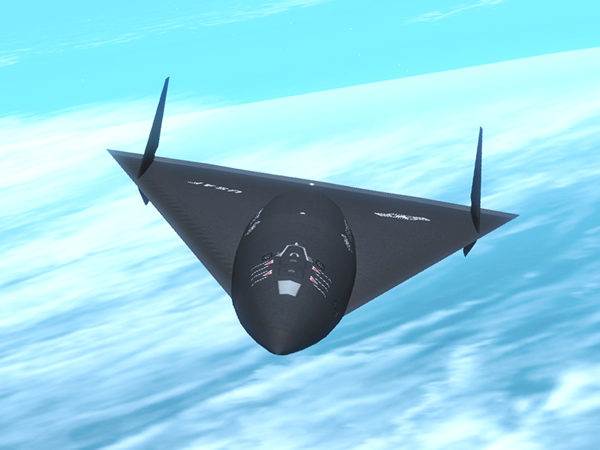 |
| Aurora plane |
Following the initial research and development of a hypersonic “scramjet”-powered aircraft in the early 1980s, and the funding of the National Aerospace Plane (NASP) in 1984 (often mischaracterized as the “Orient Express”), rumors began to swirl that either the Air Force or the National Aeronautics and Space Administration (NASA) had already funded a secret, ultrafast aircraft code named “Aurora.” Adding to the rumors, the SR-71 Blackbird was retired in the 1980s, leaving the United States ostensibly with no human-piloted supersonic spy aircraft.
Popular Science frequently ran artists’ illustrations of a “secret, hypersonic jet” that was supposedly based at Area 51 near Groom Lake, Nevada— the site of the Defense Department’s most classified projects. The aircraft’s proposed propulsion was as shrouded in mystery as its existence.
NASP was to use a supersonic combustion ramjet, which requires no moving parts to achieve compression of the air as a turbojet does, but instead relies on the forward speed of air coming through the intake to a funnel to compress the air, known as “scramjet.”
  |
This itself constituted a major obstacle in the program, because no wind tunnel even existed to test any article at a speed beyond Mach 8, while tunnels capable of testing larger articles for longer times could only generate winds up to Mach 5. (NASP was intended to fly at Mach 25, while Aurora, according to the magazine accounts, was supposedly capable of Mach 10.) Thus, the concept for building the aerospace plane as an entire aircraft system in the first place rested, in part, on the premise that to “test it you had to fly it.”
The “Pumpkin Seed,” another propulsion system linked to Aurora, involved a shock-wave pulse engine in which the exploding fuel propelled the aircraft through the sky at hypersonic speeds by exerting pressure on the aircraft’s flattened body, as when one squeezes a pumpkin seed between the thumb and forefinger. The “Pumpkin Seed” supposedly released a telltale vapor trail of smoke in puffs, much like a cigarette, rather than a steady stream.
The more widely held view of the propulsion system of any secret spy plane involved the scramjet, which needed another engine to get it up to supersonic speeds, at which point the scramjet could take over. A scramjet, in the most simplistic sense, is a funnel that compresses air going into the intake. The compression of the air forces it through the engine at vastly faster speeds, like putting one’s thumb over the end of a hose to accelerate the stream of water.
Igniting and combusting the fuel is a monumental task, compared to lighting a match in a hurricane. To facilitate combustion and airflow, the entire aircraft must become part of the engine design, with the forebody an intake and the aft section an exhaust. Eventually, most experts agreed a “lifting body” design (wide and flat, with short, stubby wings) was desirable.
If observers reported seeing a “Pumpkin Seed” aircraft that supposedly was the Aurora, another variant of the “secret hypersonic jet” story involved diverted funding from the NASP program. According to this well-circulated view, NASP was a front program to channel money to the real hypersonic program, the Aurora. In this theory, NASP was deliberately underfunded so as to keep it barely operable while the real support went to the black hypersonic program.
Artist conceptions of Auroras appeared, usually with text claiming they were already in existence and conducting spy operations. Most of these reports placed the speeds at between Mach 6 and Mach 10. And yet another variant of the story had the Aurora as a stealth aircraft— something extremely difficult to accomplish at the speeds credited to it.
Meanwhile, NASP found its funding cut repeatedly, until the goal of constructing an actual aircraft—even a subscale vehicle, which partially used rocket power—was abandoned. By that time, the Air Force and NASA still struggled with a scaled-down project to fly a scramjet atop a Minuteman missile, and even that was canceled.
When NASP ended in 1995, it had failed to build any full-sized scramjet engines, let alone an aircraft powered by a scramjet. The NASP/scramjet technology was divided into three smaller programs, including the X-33 and Hyper-X programs.
Rumors, however, continued to circulate about a new hypersonic spy plane called the Aurora. As early as 1992, the Wall Street Journal ran the headline “Evidence Points to Secret U.S. Spy Plane,” and a year later, Popular Science touted a “Secret Mach 6 Spy Plane.” Starting in 1994, Popular Science frequently ran articles on “the Secrets of Groom Lake.”
That year, the Federation of American Scientists alleged that NASP money was diverted for Aurora, claiming that Aurora’s budget was “hidden in plain sight” with the aerospace plane. In fact, the NASP budget was minuscule compared to the technological challenge. By 1990, according to the original 1986 plans, the program was to have been at $1 billion per year and was increasing.
Instead, it was at $250 million and falling—an amount that could not fund any serious technology, let alone a “super secret spy plane.” A more significant issue for the proponents of the Aurora to address was the lack of progress on any kind of scramjet engines. Numerous tests, at dozens of Air Force and NASA labs associated with NASP by 1995, had yet to get scramjet engines to generate thrust over drag.
Moreover, the tests that had been conducted involved running scramjets at fractions of seconds. Whereas the Blackbird utilized existing technology, improved by important innovations, moving an aircraft to the Mach 6–Mach 10 levels would have required an order-of-magnitude leap in technology not present in U.S. aeronautics in the 1990s.